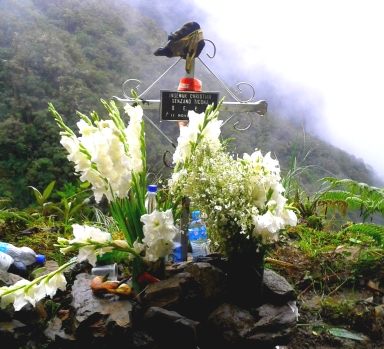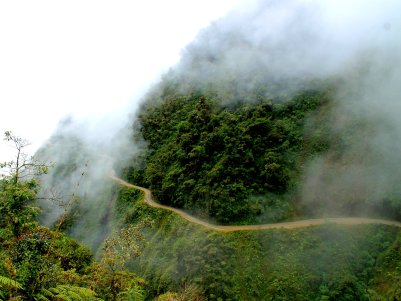I’ve never been one to take life lightly, so I don’t know why I decided to dabble with death on a whim.
It was my third day in Bolivia and I’d journeyed three hours out of the frenzy of sky-high La Paz to Coroico, a subtropical little muddle of a town perched on a mountaintop in the North Yungas region.
There, late one night after the dregs of a bottle of syrupy Bolivian wine had been drained, two angel-faced Germans propositioned me. “Tomorrow we’re cycling the Death Road. Come with us?” they coaxed. So I did.
I then knew little about the notoriety of ‘el camino de la muerte’; a dramatically steep, perilously narrow dirt track that coils around an Andean cliff face between La Paz and Coroico. Starting at 4,800 metres and plunging to 1,200 metres in just 40 mile, it gained its macabre nickname due to the high frequency of Bolivian buses tumbling off its edges into deep gorge and tangled vegetation below.
Some 300 annual fatalities were reported in the 1990s and it was then that the camino gained its title as The World’s Most Dangerous Road. When a new route was paved to redirect buses in 2007, the abandoned Death Road was claimed by thrill-seeking cyclists looking to test their nerves on a heart-racing, downhill descent. And apparently, I was to become one of them.
We set out early in the morning with heads as heavy as the thick rainclouds that masked the Andean peaks looming around us. In Coroico’s central square we met our guides; a pack of excitable young locals who clambered nimbly about a beat-up minivan to secure mud-encrusted mountain bikes to the roof. With them we drove more than an hour up the vast, winding valley with hearts fluttering and heads bobbing to their blaring, base-heavy music and the thuds of the rutted mountain road.
 Our starting point awaited us with biting cold and drizzling rain. Fitted with knee pads and helmets, we set out into the gloomy abyss.
Our starting point awaited us with biting cold and drizzling rain. Fitted with knee pads and helmets, we set out into the gloomy abyss.

The first thing I noticed was the sheer bumpiness of the whole experience. My entire body shook as I navigated my thick wheels over pieces of jagged rubble that had tumbled down the mountainside. White knuckles clasped to the handlebars, I focussed on steering around the potholes, only daring to snatch a few desperate glances over the vertical drop beside me. A series of flower-strewn graves dotted along the cliff edge were an ominous warning of the fate that awaited me if, even for a second, I lost concentration. At some point my grip loosened, the rain ceased and the clouds lifted. I became aware of the spectacular countryside around me, now illuminated in celestial sunlight. Picking up speed, we raced our guides around hairpin turns, under gushing waterfalls and over rickety bridges with reckless and ecstatic abandon. In the lush. lower terrain, colourful butterflies danced around our handlebars and the humid air was heady with aromatic herbs that peppered the grassy verge.
At some point my grip loosened, the rain ceased and the clouds lifted. I became aware of the spectacular countryside around me, now illuminated in celestial sunlight. Picking up speed, we raced our guides around hairpin turns, under gushing waterfalls and over rickety bridges with reckless and ecstatic abandon. In the lush. lower terrain, colourful butterflies danced around our handlebars and the humid air was heady with aromatic herbs that peppered the grassy verge.
We crossed the finish line in the village of Yolosa to a chorus of cheers and shared a celebratory beer before returning to Coroico feeling nothing less than invincible.
On the way back, we passed a small crowd gathered along the roadside. Our driver rolled down the window and exchanged a few hurried mumbles. A minivan had shot off the side just minutes earlier, we learned.
The rest of the ride was spent in sober contemplation.While we may had conquered Bolivia’s most famous Death Road, others – less known but just as deadly – surely lay ahead.
Cycling Bolivia’s Death Road can be organised through various tour agencies in Coroico such as Barracuda Biking. Day tours also go from La Paz.






